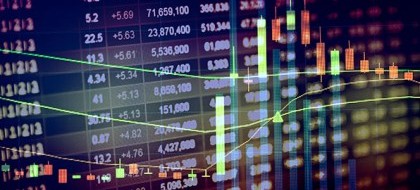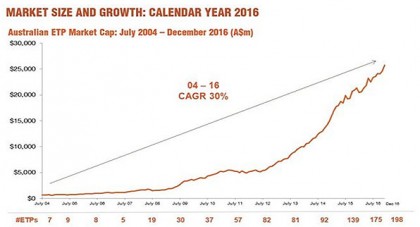 Exchange Traded Funds (ETFs) are increasingly becoming a crucial part of an investor’s tool kit, offering exposure to factor tilts and different asset classes and geographies in a highly liquid, simple and cost-effective manner. They have proved incredibly popular with investors and financial advisers. ETF growth is expected to continue as investor awareness increases and continued product innovation takes place. Active Exchange Traded Funds (Active ETFs) are at the forefront of this innovation in Australia.
Exchange Traded Funds (ETFs) are increasingly becoming a crucial part of an investor’s tool kit, offering exposure to factor tilts and different asset classes and geographies in a highly liquid, simple and cost-effective manner. They have proved incredibly popular with investors and financial advisers. ETF growth is expected to continue as investor awareness increases and continued product innovation takes place. Active Exchange Traded Funds (Active ETFs) are at the forefront of this innovation in Australia.
How does an ETF work?
In essence, an ETF functions as a way to gain fractional ownership over a portfolio of securities or other assets. ETFs are open-ended, similar to a traditional managed fund, but are traded on an exchange (such as the ASX) just like a share. ETFs experience live price changes throughout the day as they are bought and sold on market. ETFs generally aim to replicate a market index exposure, such as the S&P 500, and provide investors with the returns of that asset class – less any fees.
The Global ETF Market
ETFs are one of the fastest growing categories of investment products in the world, with over US$3.8 trillion of assets held in over 6,700 products globally. A key reason for their popularity is that they exhibit all the advantages of stocks, such as being easy to trade and liquidity, coupled with the benefits of managed funds, such as diversification.
The Australian ETF Industry
The Australian ETF industry, while comparatively small on a global scale, has grown dramatically over the last few years. As the chart below shows, the total market capitalisation of all ETF assets has grown from around A$6 billion in December 2012 to over A$25 billion in December 2016.

Source: BetaShares Australian ETF Review – year end 2016 report, 31 January 2017
Australia’s Active ETFs
There has long been a desire to give retail investors in Australia direct and straightforward access to invest in managed funds. While the Listed Investment Company (LIC) has been quite a popular mechanism, LICs are closed-ended and as such can often trade at a premium or discount to the portfolio’s Net Asset Value(NAV), meaning that investor performance does not always reflect performance of the underlying securities. But now Active ETFs have been launched, providing a flexible and more accurate method for retail investors to gain direct access to active managed funds.
Active ETFs enable delivery of the active investment management capabilities, which aim to outperform their benchmark or index, unlike passive ETFs. Active ETFs allow for new units to be added or subtracted on a daily basis according to investor demand (not possible under the LIC structure), so they generally trade close to the NAV of all the underlying securities. Additionally, Active ETFs can also be considered more transparent than traditional managed funds as they provide intra-day pricing via the exchange, whereas traditional managed fund prices are only set once per day or less frequently.
AMP Capital has recently launched three Active ETFs that aim to replicate the portfolios of some of our most successful active managed funds. They are:
-
DMKT – AMP Capital Dynamic Markets Fund (Hedge Fund)
-
GLIN – AMP Capital Global Infrastructure Securities Fund (Unhedged) (Managed Fund)
-
RENT – AMP Capital Global Property Securities Fund (Unhedged) (Managed Fund)
What are the investor benefits of AMP Capital’s Active ETFs?
-
Access: Active ETFs can be accessed on the ASX using any broker.
-
Liquidity: The Active ETFs act as their own market maker to provide liquidity for investors.
-
Diversification: All AMP Capital Active ETFs offer exposure outside of the Australian stock market and provide access to a full portfolio of diversified exposure in just one trade.
-
Ease: Active ETFs can be managed and reported-on alongside shares and all other broker portfolio holdings.
The risks of investing in ETFs
There are risks in allocating large portions of capital to highly liquid ETFs when the underlying assets they hold are relatively illiquid. In such a scenario, it may not be possible to liquidate the underlying assets to meet the redemption demand in extreme selloffs. This scenario occurred on 8 August, 2015 when China devalued the Renminbi (CNY) and some ETFs sold off heavily meaning that they were in fact trading at a significant discount to their NAV. This occurred again on 9 November, 2016 in the wake of Donald Trump’s surprise victory in the US elections.
This issue also highlights one of the major market impacts that ETFs are creating. Given that many people trade ETFs for non-active stock selection reasons, the correlation between the market and large cap stocks has grown dramatically as ETF trading has proliferated, because these stocks see the biggest index ETF trade flows.
Conclusion
ETFs have taken off and are undoubtedly changing the investment landscape across the world. The addition of Active ETFs in Australia has broadened their usability by allowing investors access to active investment management capabilities via the simple and clean ETF structure. As with any investment, investors need to take precautions by analysing how ETFs and Active ETFs are structured and it’s important they are aware of the risks and associated costs. In general, so long as these precautions are adhered to, ETFs can be a valuable addition to portfolios.
For more information on AMP Capital’s Active ETFs please click here.
Source: AMP Capital 10 March 2017
Angus Nicholson, Investment Strategist
BetaShares Capital Ltd (ACN 139 566 868, AFSL 341181 (“BetaShares”) is the responsible entity and the issuer of units in the AMP CAPITAL DYNAMIC MARKETS FUND (HEDGE FUND), AMP CAPITAL GLOBAL INFRASTRUCTURE SECURITIES FUND (UNHEDGED) (MANAGED FUND), AMP CAPITAL GLOBAL PROPERTY SECURITIES FUND (UNHEDGED) (MANAGED FUND), (each a “Fund”). AMP Capital is the investment manager of the Funds and has been appointed by the responsible entity to provide investment management and associated services in respect of the Funds. Investors should consider the Product Disclosure Statement (PDS) for the relevant Fund before making any decision regarding the Fund. The PDS contains important information about investing in each Fund and it is important investors read the PDS before making a decision about whether to acquire, continue to hold or dispose of units in the Funds. Neither BetaShares, AMP Capital, nor any other company in the AMP Group guarantees the repayment of capital or the performance of any product or any particular rate of return referred to in this information.
Past performance is not a reliable indicator of future performance.
While every care has been taken in the preparation of this information, BetaShares and AMP Capital make no representation or warranty as to the accuracy or completeness of any statement in it including without limitation, any forecasts. This content has been prepared for the purpose of providing general information, without taking account of any particular investor’s objectives, financial situation or needs. Investors should, before making any investment decisions, consider the appropriateness of this information, and seek professional advice, having regard to their objectives, financial situation and needs.



